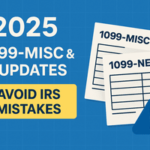As the new tax year rolls in, businesses, freelancers, and accountants alike are preparing for a fresh round of reporting and compliance. One area that continues to cause confusion and costly mistakes is the 1099 filing process—specifically the use of 1099-MISC, 1099-NEC, and Form W-9 for independent contractors.
The IRS 2025 updates bring a few changes that are easy to overlook but can result in audits, delayed processing, or even fines. In this blog, we’ll break down what’s new for 2025, clarify the differences between 1099 forms, and show you how to stay compliant while avoiding common IRS pitfalls.
Why the 1099 Process Matters in 2025
If you’ve ever hired a freelancer, consultant, gig worker, or other independent contractor, you’re likely familiar with Form 1099. The IRS requires businesses to report nonemployee compensation and certain other payments through a series of 1099 forms—most commonly the 1099-NEC and 1099-MISC.
Failing to file correctly or on time can lead to penalties ranging from $60 to $310 per form, depending on how late the correction is made. With the IRS 2025 now increasing scrutiny on misclassified workers and mismatched forms, it’s more important than ever to get it right.
What’s New for 2025: Key IRS Updates
While the structure of 1099-NEC and 1099-MISC hasn’t dramatically changed, here are some important 2025 updates to be aware of:
✅ Electronic Filing Threshold Decreased
Starting in 2025, if you file 10 or more information returns of any type (including W-2s and all 1099 forms), you are required to file electronically. The previous threshold was 250 forms. This change will affect many small businesses that previously filed on paper.
✅ TIN Matching Enforcement
The IRS 2025 updates emphasize matching Taxpayer Identification Numbers (TINs) with names provided on Form W-9. A mismatch can result in backup withholding or rejected returns. Verifying TINs through the IRS TIN Matching Program before filing is highly recommended.
✅ Increased IRS Audits for Contractor Classification
The IRS is intensifying efforts to identify businesses that misclassify employees as independent contractors. Make sure you’re applying proper classification rules and issuing the correct 1099 form to avoid fines and audits.
1099-NEC vs. 1099-MISC: Which One Do You Use?
A common source of confusion is knowing whether to issue a 1099-MISC or 1099-NEC. Here’s a quick breakdown:
Use 1099-NEC if you paid…
-
$600 or more to a non-employee individual (such as a freelancer or contractor)
-
Payments for services related to your trade or business
-
Direct payments made to an independent contractor (not through a payroll service or employer)
Use 1099-MISC for…
-
Rent payments
-
Prizes and awards
-
Medical and health care payments
-
Attorney fees (when not for services directly performed)
In short, if you’re paying someone for services, chances are you’re using the 1099-NEC. But if it’s for other miscellaneous payments, the 1099-MISC is still your go-to.
The Crucial Role of Form W-9
Before issuing a 1099 form, it’s essential to collect a Form W-9 from the individual or business you’re paying. This form provides the necessary details like name, business name (if applicable), address, and taxpayer identification number (TIN or SSN).
IRS 2025 guidance stresses the importance of getting a complete and accurate Form W-9 before you make your first payment. Here are some tips:
-
Always request Form W-9 upfront.
-
Check for completeness and legibility.
-
Use the TIN Matching tool to validate information.
-
Store it securely for at least four years.
Failure to collect a valid Form W-9 may result in backup withholding of 24% on future payments and additional reporting problems during tax season.
Common 1099 Filing Mistakes to Avoid in 2025
With stricter rules and a closer IRS eye, you’ll want to steer clear of these common filing errors:
❌ Missing the January 31 Deadline
For 1099-NEC forms, the IRS requires that you file and send copies to contractors by January 31, 2025. Late submissions can incur penalties—don’t delay.
❌ Incorrect TIN or Name Mismatches
As mentioned, mismatched information can lead to rejected forms. Always verify TINs before submitting.
❌ Filing the Wrong Form
Sending a 1099-MISC instead of a 1099-NEC (or vice versa) may not seem like a big deal, but it can cause delays and IRS issues. Make sure to understand the nature of each payment.
❌ Not Filing Electronically When Required
If you have 10 or more information returns, you must now file online. Paper forms will no longer be accepted in these cases.
Who Needs to File 1099s in 2025?
Any business or self-employed individual who pays $600 or more to another business or person for services during the year may need to file a 1099 form. This includes:
-
Small businesses
-
Gig economy platforms
-
Freelancers
-
Real estate investors
-
Nonprofits
Even if you’re a solo entrepreneur, if you hire help for web design, marketing, or consulting, and they’re not incorporated, a 1099-NEC is likely required.
Wrap-Up: Stay Ahead of 2025 IRS Changes
Navigating 1099-NEC, 1099-MISC, and Form W-9 rules in IRS 2025 doesn’t have to be stressful. By staying informed and adopting smart practices now, you can avoid penalties, prevent delays, and protect your business from unwanted IRS attention.
Here’s your 2025 filing checklist:
-
✅ Collect Form W-9s before making payments.
-
✅ Understand when to use 1099-MISC vs. 1099-NEC.
-
✅ Verify TINs to prevent mismatches.
-
✅ File electronically if you meet the 10-form threshold.
-
✅ Meet the January 31 filing deadline for 1099-NEC.
Being proactive today means peace of mind tomorrow. If you’re unsure, consult a tax professional or use trusted e-filing software to streamline the process.

